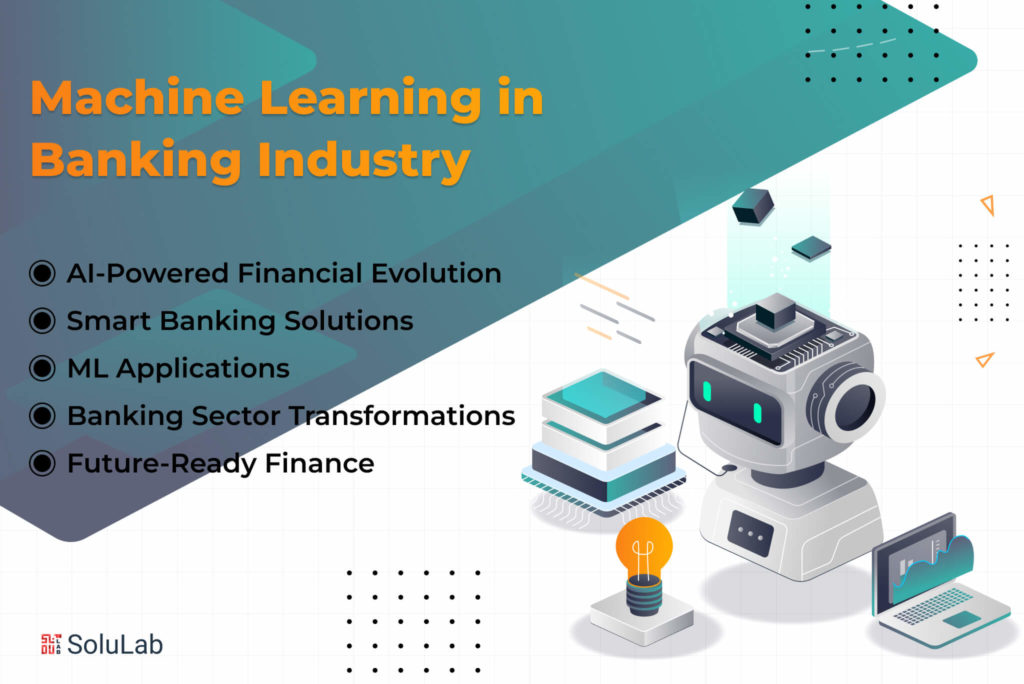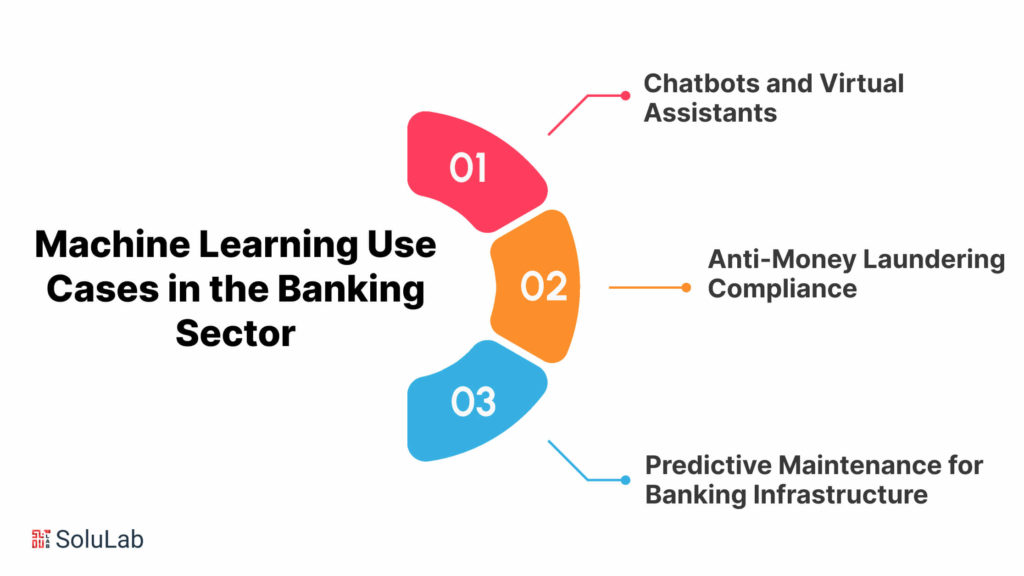
The blog discusses the transformative impact of Machine Learning (ML) on the banking sector. ML has revolutionized conventional banking practices, propelling banks into limitless possibilities. The integration of ML technologies is seen as a beacon of hope, guiding banks toward success in the digital age. The blog explores the profound effects of ML on customer experience, risk management, and other areas. Through real-world case studies and expert insights, the blog showcases how ML is reshaping banking, enabling financial institutions to achieve efficiency, security, and innovation. It emphasizes how ML is shaping a future where banks can anticipate and respond to customer needs in real-time. By unlocking the potential of ML in banking, banks can drive transformative change and be part of a movement that is reshaping the industry for the better.
Understanding Machine Learning in Banking
At its core, Machine Learning in banking represents a paradigm shift in leveraging computational algorithms to analyze data patterns. This iterative learning process empowers computers to enhance predictive capabilities and make informed decisions, propelling the financial sector into a new era of efficiency.
Defining Machine Learning:
Machine Learning in banking sector (ML), a subset of Artificial Intelligence (AI), enables computer systems to learn and enhance their performance based on experience without explicit programming. In banking, ML can revolutionize operations by analyzing vast datasets, identifying patterns, and making data-driven predictions.
Specific examples of ML applications in banking include:
1. Fraud Detection: ML algorithms analyze historical transaction data to identify suspicious patterns indicative of fraud, proactively flagging potential fraudulent transactions for further investigation.
2. Credit Scoring: ML models assess loan applicants’ creditworthiness by analyzing various data points, allowing banks to make informed lending decisions, reduce default risks, and improve loan portfolio quality.
3. Personalized Recommendations: ML algorithms analyze customer data to identify their financial needs and preferences, enabling banks to offer personalized product and service recommendations that enhance customer satisfaction and drive revenue growth.
4. Risk Management: ML plays a vital role in managing various banking risks, including market, operational, and credit risks, by analyzing vast amounts of data to assess risk exposures, predict potential losses, and optimize risk management strategies.
5. Customer Service: ML-powered chatbots and virtual assistants revolutionize customer service by providing 24/7 support, answering queries, and resolving issues, enhancing customer experience and reducing the burden on human representatives.
As ML technology continues to evolve, more innovative and transformative applications are expected to emerge in the banking industry.
Significance in the Banking Industry:
The integration of machine learning (ML) into banking operations is revolutionizing the banking sector. ML offers banks a versatile toolkit to navigate digital disruption:
1. Enhanced Customer Experiences: ML algorithms analyze vast amounts of customer data to personalize products and services in real time, leading to increased satisfaction and loyalty.
2. Optimized Risk Management: ML plays a pivotal role in bolstering banks’ risk management capabilities by identifying patterns and anomalies, minimizing financial losses and safeguarding the integrity of the banking system.
3. Streamlined Operations: The automation capabilities of ML streamline banking operations, reducing manual workloads, and enhancing efficiency.
4. Fraud Detection and Prevention: ML algorithms are adept at detecting fraudulent transactions in real time, significantly reducing financial losses and preserving customer trust.
5. Personalized Financial Advice: With ML-powered financial advisory tools, banks can provide customers with personalized insights and recommendations, empowering them to make informed financial decisions.
By embracing ML, banks transform into agile, customer-centric organizations that thrive in the digital age.
Evolution of ML in Finance:
The integration of machine learning (ML) in finance has revolutionized various aspects of banking operations. ML algorithms play a crucial role in risk assessment, fraud detection, customer service, personalized banking, and operational efficiency. In risk assessment, ML algorithms analyze historical data to identify patterns and anomalies, enhancing accuracy and enabling informed decision-making. In fraud detection, ML algorithms analyze vast transaction data to detect suspicious activities and provide real-time alerts, reducing financial losses and protecting customers.
For customer service, ML-powered chatbots offer 24/7 assistance, understand natural language, and resolve common issues efficiently. Personalized banking experiences are tailored to individual preferences, spending habits, and financial goals using ML algorithms. In operational efficiency, ML automates tasks, streamlines processes, and optimizes resource allocation, increasing productivity and cost reduction. As technology advances, the potential of ML in finance continues to drive innovation and advancements in the financial sector.
Machine Learning Transforming Banking Operations
The banking industry is witnessing a seismic shift with the integration of Machine Learning. This technology has become indispensable for financial institutions, offering insights, improving customer experiences, and optimizing operational processes. The industry’s adaptability to advanced technologies positions it as a trailblazer in embracing innovative solutions.
1. Enhancing Customer Experience:
Machine learning (ML) algorithms are transforming banking by enhancing customer experience, driving operational efficiency, and mitigating risks.
- Chatbots development provide instant customer support, understanding queries, and resolving simple issues without human intervention.
- Personalized recommendations based on a customer’s financial data help them make informed decisions and achieve financial goals.
- Fraud detection algorithms analyze transaction data to identify suspicious patterns, protecting customers from financial loss.
- Additional applications of ML in banking include credit scoring, customer segmentation, and risk management.
Overall, ML is a powerful tool that has a major positive impact on the banking industry.
2. Fraud Detection and Security:
Machine learning (ML) is a powerful tool for fraud detection in the financial industry. It can identify unusual patterns of activity that may indicate fraud, such as large/small transactions or suspicious network traffic. By using ML, banks and other financial institutions can significantly reduce their risk of fraud. It can also identify potential risks before they occur, allowing banks to take steps to mitigate them.
Here are some specific examples of how ML is being used for fraud detection:
- Transaction monitoring
- Network traffic analysis
- Device fingerprinting
- Behavioral analytics
ML is a powerful tool that can help banks and other financial institutions stay one step ahead of fraudsters and protect their customers’ money.
Credit Scoring and Risk Assessment:
Machine Learning in Banking industry (ML) models are transforming traditional credit scoring methods by analyzing a wider range of data, including non-traditional sources, to provide a comprehensive view of an individual’s financial standing. ML models offer advantages such as swiftly processing vast amounts of data, identifying complex patterns, and making accurate and unbiased lending decisions. By considering alternative data sources, banks can expand their customer base and promote financial inclusion. However, challenges include ensuring fairness, interpretability, and data security. Robust validation and testing are crucial for accurate predictions, and banks must invest in data security measures to maintain customer trust. In conclusion, the integration of ML in credit scoring enhances efficiency, accuracy, and inclusivity in the banking sector, offering significant potential benefits.
AI and Machine Learning Revolutionizing the Banking Industry

Artificial Intelligence (AI) and Machine Learning in Banking industry share a symbiotic relationship in banking, where AI provides overarching intelligence, and ML refines algorithms through continuous learning. This partnership enhances decision-making processes, augments customer interactions, and ensures adaptability to the dynamic banking landscape.
Personalized Banking Services:
Artificial Intelligence (AI) and Machine Learning in Banking industry (ML) are transforming the banking industry by enabling personalized experiences for customers.
Key Transformations:
- Tailored Product Recommendations: AI analyzes customer data to provide personalized product recommendations, such as high-yield savings accounts or investment opportunities.
- Enhanced Customer Experience: AI-powered chatbots and virtual assistants offer 24/7 support, answering questions and resolving issues instantly.
- Fraud Detection and Prevention: ML algorithms analyze transaction patterns to detect suspicious activities and protect customers from financial loss.
- Personalized Financial Advice: AI-driven financial advisory tools provide customized insights and recommendations based on each customer’s unique financial situation.
- Streamlined Task Automation: AI and ML automate repetitive tasks like data entry and customer verification, freeing up employees for more strategic activities.
Examples of banks leveraging AI and ML include JPMorgan Chase, Bank of America, and Wells Fargo. Ongoing advancements in AI and ML will continue to drive the transformation of banking services, delivering more personalized, efficient, and secure experiences to customers.
Operational Efficiency and Automation:
The banking industry is undergoing a transformation through automation driven by advanced machine learning in banking sector algorithms. This technology streamlines operational processes, leading to increased efficiency and improved customer service. Automation impacts document verification, traditionally a manual and time-consuming process. Machine learning in banking sector algorithms analyzes large volumes of documents quickly and accurately, identifying discrepancies and potential issues that might have been missed by human reviewers. Automation also transforms routine transactions and data entry tasks, freeing up bank employees to focus on more strategic and complex tasks that require human expertise and decision-making. The implementation of automation in banking has several advantages, including increased efficiency, improved accuracy, enhanced customer service, cost reduction, and increased compliance. As automation advances, banks explore new ways to leverage their potential fully, enhancing competitiveness, driving growth, and delivering an exceptional customer experience.
Predictive Analytics in Finance:
Predictive analytics empowers banks to forecast future trends, anticipate market movements, and make informed decisions. It offers several key benefits:
- Forecasting Market Fluctuations: Predictive analytics enables banks to identify potential opportunities and challenges by analyzing historical data, current market conditions, and external factors.
- Anticipating Customer Needs: By analyzing customer behavior and preferences, banks can develop personalized products and targeted marketing campaigns, enhancing customer satisfaction and driving revenue growth.
- Detecting Fraud and Financial Crime: Predictive analytics helps identify suspicious transactions and uncover potential fraud, protecting customers’ funds and ensuring the integrity of the financial system.
- Optimizing Operational Efficiency: Analyzing data on customer service, employee productivity, and resource allocation helps banks streamline operations and reduce costs.
- Enhancing Risk Management: Predictive analytics provides insights into potential risks and vulnerabilities, enabling banks to assess creditworthiness and make informed lending decisions.
Overall, predictive analytics is transforming the financial landscape for banks, enabling them to optimize strategies, reduce risks, deliver exceptional customer experiences, and drive growth and profitability.
Application of Machine Learning in Banking and Finance
The application of Machine Learning (ML) in banking and finance heralds a new era of innovation, reshaping traditional practices and driving unprecedented efficiency. This section unravels the multifaceted impact of ML applications within the financial realm, exploring how these technologies optimize processes, enhance decision-making, and redefine customer experiences. Delve into the transformative power of ML as it navigates through various applications, propelling the banking and finance sector into a dynamic and technologically advanced future.
Algorithmic Trading:
Machine learning algorithms are revolutionizing algorithmic trading by enabling the analysis of vast historical data, providing traders with an edge in volatile markets. Key advantages include enhanced data analysis, swift trade execution, reduced human error, and customization flexibility. The future holds even greater possibilities with the development of more sophisticated algorithms, enhanced signal generation, improved risk management, and optimized portfolio management. As machine learning continues to evolve, it will play an increasingly pivotal role in shaping the future of algorithmic trading.
Dynamic Fraud Prevention:
Traditional rule-based systems for fraud prevention struggle to keep up with evolving fraud tactics. Machine learning (ML) offers a proactive approach by training algorithms on historical data to identify patterns indicative of fraud. These algorithms can detect anomalies in real-time transactions, allowing businesses to stop fraudulent activities before they cause damage. ML algorithms are adaptable and can be continuously retrained, making them more effective than rule-based systems. Some advantages of using ML for fraud prevention include:
- Real-time detection: ML algorithms can detect fraud as new transactions occur.
- Adaptability: ML algorithms can adapt to changing fraud tactics through continuous retraining.
- Reduced false positives: ML algorithms can be tuned to minimize false positives.
- Scalability: ML algorithms can handle large volumes of data, making them suitable for large businesses.
Customer Sentiment Analysis:
Sentiment analysis, facilitated by Machine Learning in Banking industry algorithms, helps banks gauge customer sentiments through vast amounts of data, including customer interactions, social media engagements, and feedback. It enables the identification of key sentiment indicators, leading to a deeper understanding of customer perceptions and concerns. Actionable insights drive targeted strategies, such as improving the digital banking experience or implementing loyalty programs. Sentiment analysis offers a competitive edge by benchmarking performance and identifying areas for advancement. Overall, it plays a pivotal role in helping banks improve customer satisfaction, foster stronger relationships, increase loyalty, and drive long-term growth.
Machine Learning Use Cases in the Banking Sector

This section delves into the strategic implementation of ML within the banking sector, exploring its impact on product customization, customer experience, and internal operational efficiency.
Chatbots and Virtual Assistants:
Chatbots powered by Machine Learning in Banking industry algorithms revolutionize customer service by offering instant responses, facilitating routine transactions, and providing a personalized touch. They enhance customer experience, improve customer satisfaction, and drive business growth. Specific examples include instant responses to inquiries, facilitation of routine transactions like payments and account balance checks, and personalized interactions based on customer data. Enterprise Chatbots empower businesses to deliver exceptional customer experiences and drive growth.
Anti-Money Laundering (AML) Compliance:
Machine learning is transforming the banking industry, particularly in the field of Anti-Money Laundering (AML). Traditional AML processes are often slow and prone to errors, but machine learning algorithms can automate and enhance these processes. By training algorithms on large datasets of historical financial transactions, banks can identify suspicious patterns indicative of money laundering with high accuracy. This automation saves time, reduces costs, improves efficiency, and enhances risk management. Ultimately, machine learning empowers banks to meet regulatory requirements, protect against financial crimes, and improve the overall customer experience.
Predictive Maintenance for Banking Infrastructure:
Machine learning plays a crucial role in enhancing banking infrastructure reliability. It enables banks to proactively identify potential hardware and system failures, optimize resource allocation, and enhance customer service. By leveraging historical data and advanced algorithms, machine learning models predict anomalies, faults, and performance issues with high accuracy. They facilitate predictive maintenance, trigger intelligent alerts, automate diagnostics, and strengthen security measures. The integration of machine learning helps banks minimize downtime, optimize resource allocation, enhance customer service, and stay competitive. Overall, machine learning empowers banks to ensure the reliability of their infrastructure and drive growth and success in the digital age.
Conclusion
The article discusses the impact of machine learning on the banking industry. SoluLab is a prominent machine learning development company in driving innovation. It emphasizes how machine learning has revolutionized banking operations, enhanced customer experiences, and strengthened security measures. SoluLab’s commitment to excellence in AI development services empowers banks to integrate AI and machine learning in Banking Industry seamlessly into their operations, reshaping industry standards and fostering growth. The company’s expertise serves as a cornerstone for banks seeking to harness the full potential of machine learning. SoluLab’s comprehensive solutions address the diverse needs of the banking sector, ranging from improving customer experiences and optimizing operational efficiency to fortifying security measures. By partnering with SoluLab, banks embark on a journey to embrace the future of banking, where innovation thrives and customer satisfaction remains the guiding principle.
FAQs
1. What is the role of machine learning in the banking industry?
Machine learning in the banking industry plays a pivotal role in automating processes, enhancing fraud detection, personalizing customer experiences, and optimizing operational efficiency. It enables banks to leverage data-driven insights for better decision-making.
2. How do AI and machine learning benefit banking and finance?
AI and machine learning in Banking Industry benefit banking and finance by improving risk management, automating routine tasks, enabling predictive analytics for customer behavior, and enhancing cybersecurity. These technologies contribute to a more efficient and secure financial ecosystem.
3. What are the key applications of machine learning in banking?
Key applications of machine learning in banking include credit scoring, fraud detection, customer service chatbots, personalized financial recommendations, risk management, and predictive analytics. These applications streamline processes and improve customer interactions.
4. How does SoluLab contribute to the integration of machine learning in banking?
SoluLab, as a leading Machine Learning Development Company, contributes to the integration of machine learning in banking by providing cutting-edge development services. Their skilled Machine Learning Developers ensure the seamless incorporation of AI technologies, optimizing banking operations.
5. Can machine learning improve security measures in the banking sector?
Yes, machine learning significantly improves security measures in the banking sector. It enhances fraud detection, identifies unusual patterns, and strengthens cybersecurity by predicting and preventing potential threats before they occur.
6. What are some real-world use cases of machine learning in banking?
Real-world use cases of machine learning in banking include personalized customer experiences through recommendation engines, automated fraud detection, credit risk assessment, chatbots for customer support, and predictive analytics for investment decisions.
7. How can financial institutions leverage SoluLab’s expertise in machine learning development?
Financial institutions can leverage SoluLab’s expertise by engaging its services for machine learning development. SoluLab’s experienced team collaborates with banks to tailor solutions that enhance efficiency, security, and innovation within the banking sector.






